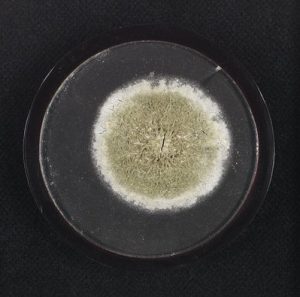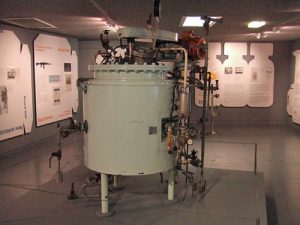8 Medical Technologies: Penicillin
Mitchell Esbenshade
8.1 Introduction
Keywords
- Antibiotics – a medicine that inhibits the growth of or destroys bacterial infections.
- Genetic Engineering – The process of modifying or manipulating an organism’s DNA.
- Synthesis – Putting together different entities or elements to make a more complex substance.
- Antimicrobial Resistance – A situation in which bacteria or fungi develop the ability to survive the drugs designed to kill them.
Learning Objectives
By the end of this chapter, students should be able to
- Have a good understanding of what penicillin is.
- Understand the role of penicillin when it was first introduced during World War II and the impact that it continued to have on society.
- Understand both the intended and the unintended long-term consequences of penicillin.
One of the most important medical innovations in recent history took place in the 1940s, when the silent generation was still growing up. Although it began as simple experiments done on an ordinary species of mold, penicillin’s antibiotic properties set it apart from many medicines of the time. Penicillin was popularized and began to be accepted in the 1940s and the 1950s, leading to a new type of medicine known as antibiotics. An antibiotic is a type of medicine used to treat bacterial infections, which is an infection caused by foreign bacteria growing in your body. This new type of medicine allowed doctors to treat infections and diseases that used to be seen as untreatable, which obviously had large effects on people’s everyday lives.
Penicillin had an incredible impact on society, saving countless lives and revolutionizing the medical industry. People saw bacterial infections in a different, much less frightening light. Most notably, penicillin saved the lives of many soldiers in World War II because it was portable and could be used to treat many different diseases. Overall, the invention and widespread use of penicillin has caused long lasting positive effects on the medical industry and society as a whole, including the control of infectious diseases which has saved countless lives.
8.2 What is Penicillin
Key Takeaway
Although it may seem like too simple of an explanation, penicillin is just mold. All of penicillin’s life-saving properties and incredible benefits come from the mold. To make the penicillin that we actually use, scientists extract the mold from its environment and purify it, so that its effects are more targeted and effective.

“Penicillin” by Centre for Research Collections University of Edinburgh is licensed under CC BY-NC-SA 2.0
When it was designed for soldiers to use in World War II, penicillin took the form of a powder and a liquid. Surgeons and field medics would put the powder in the soldier’s wounds and prescribe liquid injections while the soldiers recovered, to ensure there was no infection. This treatment was incredibly effective, so much so in fact that the survival rate went from 4% in World War I to 50% in World War II due to the use of penicillin (Britannica 2021). Years later, penicillin was made into tablets which made it much more effective in everyday life. Doctors were able to prescribe penicillin to treat infections in a simple and effective way.
As time has passed, scientists discovered newer, more efficient ways to produce penicillin. Because of this, the exact definition of penicillin is not entirely clear. Penicillin has been genetically engineered to become easier to manufacture and mass produce. This means that penicillin’s DNA has been modified so that it has different properties than it naturally does. In modern times, the term penicillin can refer to a number of different antibiotics that have the same core chemistry as penicillin does but still provides similar antibiotic benefits.
8.3 History of Penicillin
Key Takeaways
When Alexander Fleming discovered penicillin in 1928, it was actually an accident. Fleming was studying different bacteria, but a mold contaminated one of his experiments. He noticed that the bacteria was being killed by the mold, which sparked interest in the mold. He studied the mold for several years, and found that it was effective against certain types of bacteria, such as those that cause meningitis and pneumonia. In 1931, Fleming stopped his research on penicillin .
In 1940, Howard Florey and Ernest Chain, two scientists at Oxford University picked up where Fleming left off. They were more qualified and had more equipment than Fleming, and as a result made more progress in researching penicillin. The biggest breakthrough they made in their research was discovering a new species of mold that yielded 200 times as much penicillin as the species they had previously been working with. This enabled them to start producing penicillin much more efficiently. Around 1939, they tested penicillin on rodents. They infected a sample of rodents with a bacteria, but gave half of them penicillin. It proved to be effective, and the stage was set for penicillin to begin use on people. They tested on a few people at this point, but penicillin’s incredible capabilities were proved through its use in World War II.
Funded by a wartime economy, penicillin production in both America and Britain increased significantly during World War II. Although penicillin was very effective in the war, it was still naturally grown. Typically, drugs and medications used to treat people are synthesized in laboratories. This means that they are made from different elements instead of being grown. Synthesized products are more reliable to create and are also more consistent. Penicillin’s structure was discovered in 1945, and was later synthesized using this information in 1957. This is how penicillin is made today.

“Penicillin Bioreactor” by Matt Brown is licensed under CC BY 2.0
8.4 Penicillin’s Impact on Society
Key Takeaways
Penicillin’s effects on society were swift and noticeable. Bacterial infections can result from any open wound, so they are common problems that people have to go to the hospital for. Before penicillin, a simple bacterial infection could result in death, even with medical attention. Once penicillin was available in hospitals, these infections no longer posed as serious of a threat, and many people’s lives were saved. Apart from rare penicillin allergies exhibited by about 1% of people treated, penicillin was a miraculous new medicine with few negative effects.

Penicillin saves soldiers’ lives!” by National Archives and Records Administration is in the Public Domain
The more interesting effects of penicillin are just now surfacing in the form of resistant strains of bacteria referred to as antimicrobial resistance. This refers to any strain of bacteria, fungi or virus that has developed resistance to the treatment typically used to kill these microbes. The Tripartite Collaboration, which is made up of the World Health Organization, the Food and Agriculture Organization, and the World Organization for Animal Health, has stated that antimicrobial resistance is one of the largest threats to global health. This is an effect of penicillin that no one in the 1940s or 1950s could have predicted. This situation may sound bad, but there is a solution currently being tested and implemented. It has been shown that reducing antibiotic use on food products and even people when necessary will help with this issue, however this restraint isn’t currently being implemented. If a strain of bacteria typically controlled by penicillin becomes resistant, it could cause major problems for our current health systems.
Case Study
The first human test of penicillin was conducted in 1941 on a man named Albert Alexander. Alexander was a police officer in Oxford, the same place in which penicillin was being researched and tested. Some believe that Alexander got an open wound in his face when he brushed against a rose, and other believe he was the victim of a bombing raid, however the hospital report doesn’t note the cause of the his infections. Alexander was admitted to the Radcliffe Infirmary due to his severe infection. His infection had spread across his eyes, face, and lungs. This was the condition Alexander was in when he began to use penicillin. Florey was looking to test penicillin on humans, and Alexander was the first person he found who he thought he could help. Alexander received penicillin injections regularly over the next 4 days, and his condition greatly improved. His infections began to heal and his temperature dropped, however this would not be for long. Florey’s laboratory had run out of penicillin, and Alexander was not given enough penicillin to completely fight off the infection. Alexander died within a month after the infection worsened again, but penicillin was proven to be an effective treatment.
Chapter Summary
Penicillin is one of the most influential discoveries in the medical field in recent history. It provided a cure for some infections and diseases which were previously thought to be untreatable. Penicillin had a period of very rapid research and improvement because of World War II, and as a result, saved many many lives. After much research and improvement, penicillin can be synthesized relatively easily and reliably, making it a staple in fighting common bacterial infections.
Review Questions
Food For Thought
- Where would we be today without the discovery of penicillin?
- If antimicrobial resistance becomes widespread, what will happen to the injections that used to be treated with penicillin?
References
Abraham, E. P., Chain, E., Fletcher, C. M., Gardner, A. D., Heatley, N. G., Jennings, M. A., & Florey, H. W. (1941). Further observations on penicillin. The Lancet, 238(6155), 177-189.
Adedeji WA. THE TREASURE CALLED ANTIBIOTICS. Ann Ib Postgrad Med. 2016 Dec;14(2):56-57. PMID: 28337088; PMCID: PMC5354621.
Alexander Fleming Discovery and development of penicillin – landmark. American Chemical Society. (n.d.). Retrieved November 9, 2022, from https://www.acs.org/content/acs/en/education/whatischemistry/landmarks/flemingpenicillin.html
Editor. (2020, May 31). How the discovery of Penicillin has influenced modern medicine. The Oxford Scientist. Retrieved November 29, 2022, from https://oxsci.org/how-the-discovery-of-penicillin-has-influenced-modern-medicine/#:~:text=The%20discovery%20of%20penicillin%20changed,threatening%20were%20now%20easily%20treated
Encyclopædia Britannica, inc. (n.d.). Find out what medical development helped World War II soldiers. Encyclopædia Britannica. Retrieved November 29, 2022, from https://www.britannica.com/video/222824/medical-inventions-World-War-II
Fleming A. Penicillin. Br Med J. 1941 Sep 13;2(4210):386. PMCID: PMC2162878.
Kardos N, Demain AL. Penicillin: the medicine with the greatest impact on therapeutic outcomes. Appl Microbiol Biotechnol. 2011 Nov;92(4):677-87. doi: 10.1007/s00253-011-3587-6. Epub 2011 Oct 2. PMID: 21964640.
Society, M. (n.d.). The history of antibiotics. Microbiology Society. Retrieved November 16, 2022, from https://microbiologysociety.org/membership/membership-resources/outreach-resources/antibiotics-unearthed/antibiotics-and-antibiotic-resistance/the-history-of-antibiotics.html
Tang KL, Caffrey NP, Nóbrega DB, Cork SC, Ronksley PE, Barkema HW, Polachek AJ, Ganshorn H, Sharma N, Kellner JD, Checkley SL, Ghali WA. Examination of unintended consequences of antibiotic use restrictions in food-producing animals: Sub-analysis of a systematic review. One Health. 2019 May 15;7:100095. doi: 10.1016/j.onehlt.2019.100095. PMID: 31193679; PMCID: PMC6538949.
World Health Day – the rise and fall of antibiotics? – 2018. ReAct. (2019, January 14). Retrieved November 16, 2022, from https://www.reactgroup.org/news-and-views/news-and-opinions/year-2018/world-health-day-the-rise-and-fall-of-antibiotics/
A medicine that inhibits the growth of or destroys bacterial infections.
The process of modifying or manipulating an organism’s DNA.
Putting together different entities or elements to make a more complex substance.
A situation in which bacteria or fungi develop the ability to survive the drugs designed to kill them.

